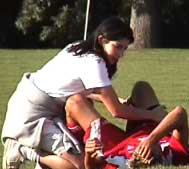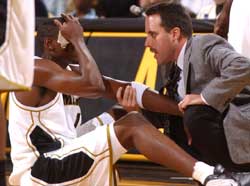How chemistry is used in Sports
Medicine/
Athletic Training
Description of the Sports
Medicine/Athletic Training profession
First of all to make it
clear to people who may be confused, Sports Medicine and Athletic Training is
the same thing. Athletic Training is the more professional way of saying it and
Sports Medicine is a more general term.
An Athletic Trainer is an allied health care professional educated and
experienced in the management of health care problems associated with sports
participation. An Athletic Trainer is skilled in prevention, assessment,
treatment and rehabilitation of injuries of the physically active.

Working with patients
who sometimes have limited use of their own bodies due to sports injuries, an
Athletic Trainer builds flexibility, strength, and spirit. His/her goals are to
reduce the patientsí pain, to increase their range of motion, and to give them
back their sense of self-determination. The Athletic Training profession is
emotionally and physically demanding. Emotional attachment to patients/athletes
is almost inevitable and sometimes when a patient's body is not responding to
the treatment they can take it on you, which leads to frustration from both
parts. Most of an Athletic Trainer's time is spent standing, crouching, bending,
and using his/her muscles; therefore, Athletic Training is as well as
emotionally a physically demanding profession.
"Why Sports Medicine?"
This is a question I hear over and over again.
I think the main reason why I chose this area of study is because I enjoy
helping people and working with them. I am also interested in the complexity of
the human body and wellness. I think that being participating in sports is very
important and it can be a lot of fun as well. Being active helps in having and
maintaining an overall positive attitude and this is the kind of people I would
like to work with: optimistic and full of life.
Different types of jobs that one
can have with an Athletic Training major
Athletic Trainers can
be found almost anywhere people are physically active. Whether they are on the
playing field or in an industrial work setting Athletic Trainers are in place to
help active people prevent injuries and stay healthy. As such, athletic trainers
may work in a variety of settings which can include: secondary schools, colleges
and universities, hospitals, sports medicine clinics, or other athletic
healthcare settings. Related career titles for Athletic Training majors can be:
High School\College\University Athletic Trainer, Team Physician, Fitness
Consultant, Exercise Physiologist, Aerobics Instructor, Personal Trainer,
Teacher, Massage Therapist, Sports Physical Therapist, Fitness Instructor,
Sports Dietician, and many others. However, several of these careers may require
education beyond a bachelor's degree.
 Many
public and private
secondary schools
offer abundant job opportunities for Athletic Trainers. Parents and
faculty are discovering the benefits a Certified Athletic Trainer can offer in
preventing and caring for injuries. Athletic Trainers care for athletes for
multiple team sports, as well as cheerleading and other spirit groups. Many
Athletic Trainers also teach classes at the high school level.
Many
public and private
secondary schools
offer abundant job opportunities for Athletic Trainers. Parents and
faculty are discovering the benefits a Certified Athletic Trainer can offer in
preventing and caring for injuries. Athletic Trainers care for athletes for
multiple team sports, as well as cheerleading and other spirit groups. Many
Athletic Trainers also teach classes at the high school level.
Certified Athletic
Training jobs in
Colleges and Universities
generally fall in two categories: athletic department staff assignment and
combination teacher/athletic trainer.
An Athletic Trainer can
also find himself/herself working for a
Professional Sport
Organization. In
this settings, Athletic Trainers are responsible for only one sport, such as
football, basketball, baseball, hockey, or soccer. Although teams operate only a
few months per year, Athletic Trainers work year-round conditioning and
rehabilitating athletes. Fewer jobs are available in this practice setting due
to the limited number of teams.
settings, Athletic Trainers are responsible for only one sport, such as
football, basketball, baseball, hockey, or soccer. Although teams operate only a
few months per year, Athletic Trainers work year-round conditioning and
rehabilitating athletes. Fewer jobs are available in this practice setting due
to the limited number of teams.
Employment in
Sports Medicine Clinics
is a growing setting that provides Certified Athletic Trainers the opportunity
to work with a number of different health care professionals and a diverse
patient population in providing rehabilitation for athletic injuries.
Scientific data & Athletic
Training
Scientific data is
important in any academic or career area. And one of these areas is also
Athletic Training. To improve the health conditions, treatment, as well as
prevention of injuries, scientific data is increasingly important as a means of
scientific communication and progress in the health care industry. For example,
the Center for Disease Control provides scientific data
on injury-related
mortality data and
nonfatal injury data
which is useful for research and for making informed public health
decisions. Other kinds of scientific data would be researches on different and
new types of medications that could improve one's health, treatment and
rehabilitation of sport injuries, as well as one's athletic performance, like
for example Creatine. There have been many researches done on Creatine to check
if it is dangerous to the body and what are possible short and long term side
effects.
The importance of the
ethical use of data to this area is as important as it is to any other area.
Using the data ethical can help practitioners make better use of the information
already available and therefore help patients and improve the health care system
throughout the world. However, an unethical use of the data can lead to harmful
effects. For example, prescribing a large dose of a drug when it is not needed,
for personal benefits such as money, can lead to a very bad health condition or
in more dramatic cases even to death. Another use of unethical data would be
telling someone that his/her injury or disease is not as bad as is it actually
is in order for them to not be hurt and scared. In some cases, especially
injuries, it is important for the patients to know how serious the injury is so
that they can help together with the Athletic Trainer in treating the injury and
taking special care of that specific injured part of the body.
Athletic Training & Chemistry
There is definitely a
clear connection between these two fields of study: Athletic Training and
Chemistry. As an allied health care career Athletic Training involves
prescription of medications. Medications are made out of chemicals and therefore
the connection between Athletic Training and Chemistry. An Athletic Trainer
needs two have some basic knowledge of chemistry to know the difference between
certain drugs, what kind of chemicals the drugs contain, and what kind of
chemicals can have a positive or negative influence on the body. For example it
is important to know what kind of chemical Magnesium is, what is its importance
to the human body, and what could happen to the human body if it does not have
the necessary amount of Magnesium needed.
Most athletes, at one
time or another, have toyed with the idea of supplementing with Creatine.
Creatine is used in muscle cells to store energy for sprinting and explosive
exercise. Athletes can increase the amount of Creatine in muscle by taking
Creatine supplements. Creatine is a compound that can be made in our bodies or
taken as a dietary supplement. The chemical name for Creatine is methyl
guanidine-acetic acid. Creatine is made up of three amino acids - Arginine,
Glycine and Methionine.

Our liver has the
ability to combine these three amino acids and make Creatine. The other way we
get Creatine is from our diet. It is known that by taking supplements of
Creatine a person can provide additional energy for his\hers muscles, increase
the volume of the muscles, help buffer lactic acid that builds-up in the muscles
during exercise, and enhance Protein Synthesis.
The question if Creatine is a harmful
supplement cannot be avoided. There have been hundreds of studies done on
Creatine that all show that it is a safe supplement. There are really very few
side effects reported with Creatine use and they include: upset stomach, muscle
cramping, diarrhea and dehydration. Most of these side effects can be minimized
by drinking plenty of water when taking Creatine. However, large doses of
Creatine or any other medications can become dangerous to the body. Liver and
kidney damage is likely to occur once you abuse Creatine.
As a conclusion, Athletic Training and
Chemistry have much in common and we can say that in many aspects they go hand
in hand. And Creatine is only one of many other examples of chemicals expected
to help or treat the human body and in the Creatine's case the physically
active.
References:
www.absolute-creatine.com
http://www.cdc.gov/scientific.htm
www.nata.org

 Many
public and private
secondary schools
offer abundant job opportunities for Athletic Trainers. Parents and
faculty are discovering the benefits a Certified Athletic Trainer can offer in
preventing and caring for injuries. Athletic Trainers care for athletes for
multiple team sports, as well as cheerleading and other spirit groups. Many
Athletic Trainers also teach classes at the high school level.
Many
public and private
secondary schools
offer abundant job opportunities for Athletic Trainers. Parents and
faculty are discovering the benefits a Certified Athletic Trainer can offer in
preventing and caring for injuries. Athletic Trainers care for athletes for
multiple team sports, as well as cheerleading and other spirit groups. Many
Athletic Trainers also teach classes at the high school level. settings, Athletic Trainers are responsible for only one sport, such as
football, basketball, baseball, hockey, or soccer. Although teams operate only a
few months per year, Athletic Trainers work year-round conditioning and
rehabilitating athletes. Fewer jobs are available in this practice setting due
to the limited number of teams.
settings, Athletic Trainers are responsible for only one sport, such as
football, basketball, baseball, hockey, or soccer. Although teams operate only a
few months per year, Athletic Trainers work year-round conditioning and
rehabilitating athletes. Fewer jobs are available in this practice setting due
to the limited number of teams. 